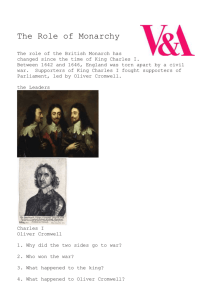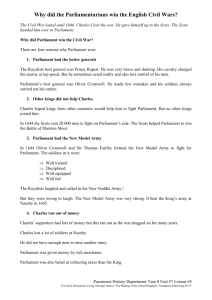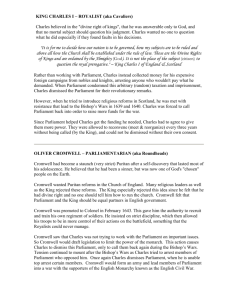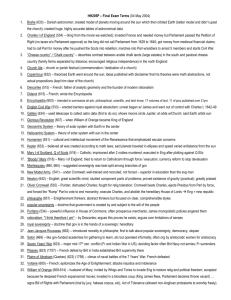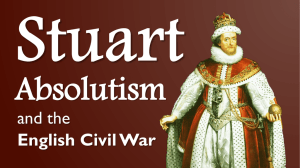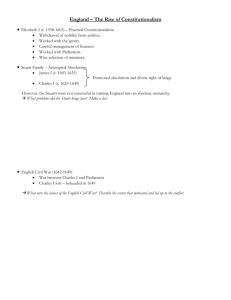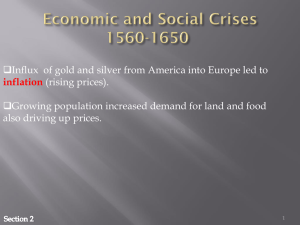The First English Civil War
advertisement
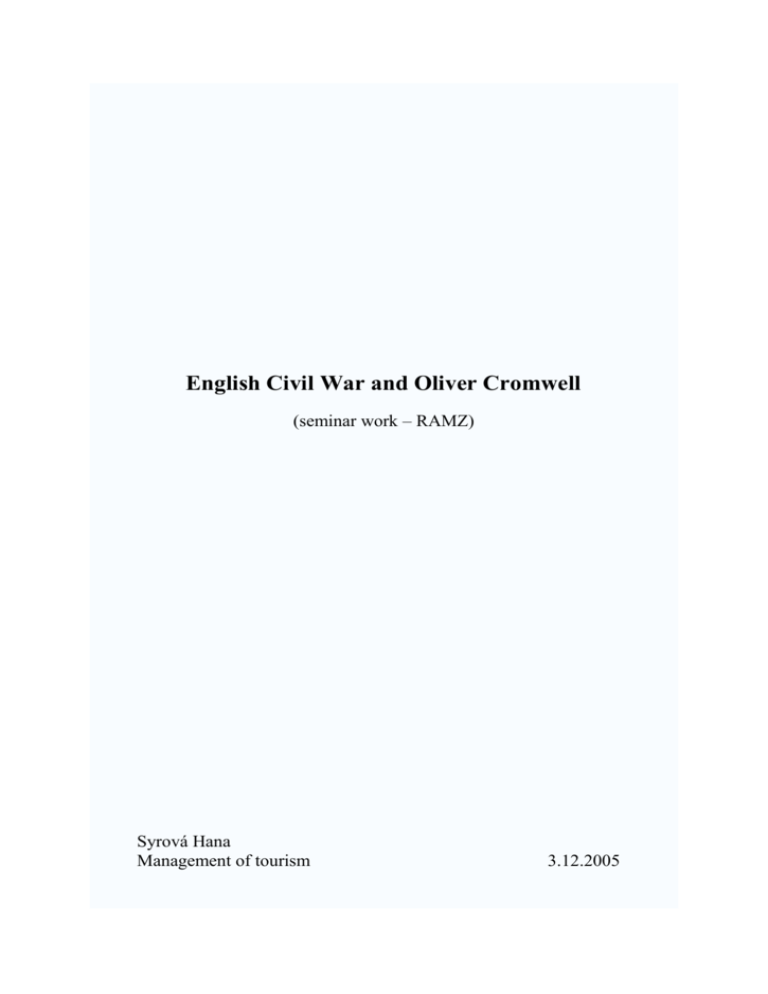
English Civil War and Oliver Cromwell (seminar work – RAMZ) Syrová Hana Management of tourism 3.12.2005 Introduction The term English Civil War (or Wars) refers to the series of armed conflicts and political machinations which took place between Parliamentarians and Royalists from 1642 until 1651. The first (1642–1645) and the second (1648–1649) civil wars pitted the supporters of King Charles I against the supporters of the Long Parliament, while the third (1649–1651) was between supporters of Charles II and supporters of the Rump Parliament. The third war ended with the Parliamentary victory at the Battle of Worcester on 3rd, 1651. The wars was mixed and formed part of a linked series of conflicts and civil wars between 1639 and 1651 in the kingdoms of England, Scotland and Ireland, which at that time shared a monarch but formed distinct countries with otherwise separate political structures. Sometimes call these linked conflicts the Wars of the Three Kingdoms. Some have also described them as the "British Civil Wars", but this terminology can mislead: the three kingdoms did not become a single political entity until the Act of Union 1800. Background Parliament against the Crown The first signs of trouble between Crown and Parliament came in 1601, when the Commons were angry over Elizabeth’s policy of selling monopolies. Like Elizabeth, James I tried to rule without Parliament as much as possible. He believed that the king was chosen by God and therefore only God could judge him, this led to trouble with Parliament. He had made the mistake of appointing Elizabeth’s minister, Sir Edward Coke, as Chief Justice. Coke made decisions which limited the king’s power. Laws could only be made by Act of Parliament. James removed Coke from the position of Chief Justice, but as an MP Coke continued to make trouble. In 1618, at the beginning of the Thirty Years War in Europe, Parliament wished to go to war against the Catholics. James would not agree. James was always quarrelling with Parliament over money and over its desire to play a part in his foreign policy. Charles I, son of the James I of England hoped to unite the kingdoms of England, Scotland and Ireland into a new single kingdom, fulfilling the dream of his father. But Charles I found himself quarrelling even more bitterly with the commons than his father had done, mainly over money. Finally he said that Parliaments are altogether in his power and dissolved Parliament. Petition of Right Having dissolved Parliament, and being unable to raise money without it, the king assembled a new one in 1628. Among the members elected was Oliver Cromwell. The new Parliament drew up the Petition of Right in 1628, and Charles accepted it as a concession in order to get his subsidy. Amongst other things the Petition referred to the Magna Carta and said that a citizen should have freedom from: arbitrary arrest and imprisonment, non-parliamentary taxation, the enforced billeting of troops, and Martial law. Nevertheless, Charles realised that the Petition made nonsense of a king’s “divine right”. He decided to prevent it being used by dissolving Parliament the following year. The Eleven Years' Tyranny and a rebellion in Scotland Charles surprised everyone by being able to rule successfully without Parliament. Charles I managed to avoid calling a Parliament for a decade. Depending upon one's political affiliation, this time was known either as the "Eleven Years' Tyranny" or "Charles' Personal Rule". By 1637 he was at the height of his power. His authority seemed to be more completely accepted than the authority of an English king had been for centuries. It also seemed that Parliament might never meet again. This policy broke down when he was involved in a series of disastrous and expensive wars against his Scottish subjects, the Bishops' Wars of 1639 and 1640. In 1637, however, Charles began to make serious mistakes. He shared his father’s dislike of Puritans. He had married a French Catholic, and the marriage was unpopular in Protestant Britain. Many MPs were either Puritans or sympathized with them. But Charles took no notice of popular feeling, and he appointed an enemy of the Puritans, William Laud, as archbishop of Canterbury. Archbishop laud brought back into the Anglican Church many Catholic practices. He tried to make the Scottish Kirk accept the same organisation as the church in England. It was very dangerous, but Charles didn’t realised it because he never lived in Scotland. Recall of Parliament In spring 1638 Charles faced a rebel Scottish army. Without the help of Parliament he was only able to put together an inexperienced army. He knew his army was unlikely to win against the Scots. So he agreed to respect all Scottish political and religious freedoms, and also to pay a large sum of money to persuade the Scots to return home. But he didn’t have enough money without Parliament. Charles must recall Parliament. It forced him to rule under parliamentary control. In return for its help. Parliament made Charles accept a new law which started that Parliament hat to meet at least once every three years. Events in Scotland made Charles depend on Parliament, but events in Ireland resulted in civil war. In 1641, Ireland exploded n rebellion against the Protestant English and Scottish settlers. As many as 3,000 people, men, women and children, were killed, most of them in Ulster. In London, Charles quarreled over who should control an army to defeat the rebels. This trait, and a series of events, led to a serious break between Charles and his Parliament, and eventually to war. Oliver Cromwell Cromwell was born in Huntingdon, Cambridge shire. He studied at Sidney Sussex College, Cambridge. Oliver Cromwell descended from Catherine Cromwell. Catherine was married to Morgan ap Williams, son of William ap Yevan and Joan Tudor. There is speculation that Joan was an illegitimate daughter of Jasper Tudor, 1st Duke of Bedford. Although Catherine married, her children kept her name, probably to disguise the male side of the family's heritage, instead of fully emphasizing the female's side from Thomas Cromwell. This heritage goes through the Tudors, de Valois, and Wittelsbach—three royal dynasties of England, France, and the Holy Roman Empire. He was an English military leader and politician. After leading the overthrow of the British monarchy, he ruled England, Scotland, and Ireland as Lord Protector, (or, some would claim, essentially as a 'dictator'), from December 16, 1653 until his death; which is believed to have been due either to malaria or by poisoning. Cromwell began his military career by raising a cavalry troop, known as the "Ironsides Cavalry", which became the basis of his New Model Army as well as Cromwell's nickname, "Old Ironsides", this system still evident in military organization today. Cromwell's leadership in the Battle of Marston Moor (in 1644) proved decisive, and marked him out as a potential political as well as a military leader. He demonstrated his military leadership ability. As a leader of the Parliamentarian cause, and commander of the New Model Army, (informally known as the "Roundheads"), Cromwell defeated King Charles I, thus bringing to an end the monarchy's claims to absolute power. The First English Civil War The "Long Parliament", having controverted the king's authority, raised an army led by Robert Devereux, 3rd Earl of Essex. The purpose of this army was twofold: it was to defeat both an invasion from Scotland and also the attempts by the king and his supporters to restore the monarchy's power. Charles I, in the meantime, had left London and also raised an army using the archaic system of a Commission of Array. He raised the royal standard at Nottingham in August. In September 1642, King Charles I addressed his troops at nearby Orleton Hall. He declared that he would uphold the Protestant Religion, the Laws of England, and the Liberty of Parliament. The "Wellington Declaration" was held to be so important that the Royal Mint stamped its slogans on the reverse of the 10/- silver coins Many areas attempted to remain neutral but found it impossible to withstand both the King and Parliament. On one side, the king and his supporters fought for traditional government in Church and state. On the other, supporters of Parliament sought radical changes in religion and economic policy and major reforms in the distribution of power at the national level. The first precipitate major siege, the first siege of Hull in July 1642, provided a decisive victory for Parliament The first pitched battle at Edgehill proved inconclusive, but both the Royalist and Parliamentarian sides claimed it as a victory. One of the king's outstanding officers, his nephew, son of Elizabeth I. Prince Rupert of the Palatinate, proved himself a dashing cavalry commander. A Parliamentarian cavalry troop raised by a country gentleman, evangelical puritan, and Member of Parliament named Oliver Cromwell. After the second field action of the war, Charles forced to withdraw to Oxford. This city would serve as his base for the remainder of the war. In 1643, the Royalist forces won at Adwalton Moor and gained control of most of Yorkshire. Subsequent battles in the west of England at Lansdowne and at Roundway Down went to the Royalists. Prince Rupert could then take Bristol. In the same year, Oliver Cromwell formed his troop of "Ironsides" Parliament won at Battle of Marston Moor in 1644, gaining York with the help of the Scots, it brought Cromwell to great prominence. Political maneuvering on both sides now led Charles to negotiate a cease-fire in Ireland, freeing up English troops to fight on the Royalist side, while Parliament offered concessions to the Scots in return for aid and assistance. In 1645, Parliament reorganized its main forces into the New Model Army, under the command of Sir Thomas Fairfax, with Cromwell as his second-in-command and LieutenantGeneral of Horse. In what were, in retrospect, two decisive engagements—the Battles of Naseby on June 14 and of Langport on July 10—Charles's armies were effectively destroyed In the remains of his English realm, Charles attempted to recover stability by consolidating the Midlands. He began to form an axis between Oxford and Newark on Trent, Nottinghamshire. He took Leicester, which lies between them, but found his resources exhausted. Having little opportunity to replenish them, on May 1646, he sought shelter with a Scottish army at Southwell in Nottinghamshire. This marked the end of the First English Civil War. Capture of Charles Charles was ransomed by Parliament and held captive at Holdenby House while Parliament drew up plans. In the meantime, Parliament began to demobilize and disband the army. The army was unhappy about issues such as arrears of pay and living conditions and resisted the disbandment. Eventually the army kidnapped Charles, using their hostage as a bargaining piece in the negotiations. He spent three months at Hampton Court Palace before escaping to the Isle of Wight, where he was recaptured and imprisoned in Carisbrooke Castle. Increasingly concerned, the army marched to London in August 1647 and debated proposals of their own at the Putney Debates. The Second English Civil War Charles I took advantage of this deflection of attention away from himself to negotiate a new agreement with the Scots, again promising church reform on December 28, 1647. Although Charles himself was still a prisoner, this agreement led inexorably to the Second Civil War. A series of Royalist uprisings throughout England and a Scottish invasion occurred in the summer of 1648. Most of the uprisings in England were put down by forces loyal to Parliament after little more than skirmishes, but uprisings in Kent, Essex and Cumberland, the rebellion in Wales and the Scottish invasion involved the fighting of pitched battles and prolonged sieges. In the spring of 1648 unpaid parliamentarian troops in Wales changed sides. The Royalist rebels were defeated by Colonel Thomas Horton at the battle of St. Fagans (May 8) and the rebel leaders surrendered to Cromwell on July 11 after the protracted two month siege of Pembroke. A Royalist uprising in Kent was defeated by Sir Thomas Fairfax at the battle of Maidstone on June 24. Fairfax, after his success at Maidstone and the pacification of Kent, turned northward to reduce Essex, where, under their ardent, experienced and popular leader Sir Charles Lucas, the Royalists were in arms in great numbers. Fairfax soon drove the enemy into Colchester, but the first attack on the town was repulsed and he had to settle down to a long siege. In the North of England Major-General John Lambert fought very successful campaign against an number of Royalist uprisings. The largest was that of Sir Marmaduke Langdale in Cumberland. Thanks to the successes of Lambert and the Scottish commander the Duke of Hamilton was forced to take the west route through Carlisle for the Royalist Scottish invasion of England. The Parliamentarians under Cromwell engaged the Scots at the Battle of Preston (August 17 – August 19), which resulted in a victory by the troops of Cromwell over the Royalists and Scots commanded by Hamilton. This Parliamentarian victory marked the end of the Second English Civil War. Trial of Charles I The Parliamentarian leaders now had a problem. They could either bring Charles back to the throne and allow hi to rule, or remove him and create a new political system. But some army commanders were determined to get rid of the king. These men were Puritans who believed they could build God’s kingdom in England. So the army marched on parliament and conducted "Pride's Purge" (named after the commanding officer of the operation, Thomas Pride) in December 1648. 45 Members of Parliament (MPs) were arrested; 146 were kept out of parliament. Only 75 were allowed in, and then only at the army's bidding. This Rump Parliament was ordered to set up a high court of justice in order to try Charles I for treason in the name of the people of England. The trial reached its forgone conclusion. 59 Commissioners (judges) found Charles I guilty of high treason, being a "tyrant, traitor, murderer and public enemy". He was beheaded on January 30, 1649. At the English restoration, under King Charles II., the regicides who were still alive and not living in exile were either executed or sentenced to life imprisonment. The Third English Civil War Ireland Ireland had known continuous war since the rebellion of 1641, with most of the island controlled by the Irish Confederates. Increasingly threatened by the armies of the English Parliament after Charles I's arrest in 1648, the Confederates signed a treaty of alliance with the English Royalists. The joint Royalist and Confederate forces under Ormonde attempted to eliminate the Parliamentary army holding Dublin, but were routed at the Battle of Rathmines. As the former Member of Parliament Admiral Robert Blake blockaded Prince Rupert of the Rhine's fleet in Kinsale, Oliver Cromwell was able to land at Dublin on August 15, 1649 with the army to quell Royalist alliance in Ireland. Cromwell's suppression of the Royalists in Ireland during 1649 still has a strong resonance for many Irish people. The massacre of nearly 3,500 people in Drogheda and Wexford after its capture—comprising around 2,700 Royalist soldiers and all the men in the town carrying arms, including civilians, prisoners, and Catholic priests—is one of the historical memories that has driven Irish-English and CatholicProtestant strife during the last three centuries. These killings were probably no worse than the killings of Protestants in 1641, but they remained powerful symbols of English cruelty to the Irish. Scotland The Scots were shocked by Charles’s execution. They invited his son, whom they recognised as King Charles II. to join them and fight against the English Parliamentary army. But they were defeated at he Battle of Dunbar on September 3rd. Cromwell’s army then took Edinburgh, and by the end of the year, his army had occupied much of southern Scotland. In July 1651, Cromwell's forces crossed the Firth of Forth into Fife and defeated the Scots at the Battle of Inverkeithing. The next year, 1652, the rest of Royalist resistance were mopped up and under the terms of the "Tender of Union", the Scots were given 30 seats in a united Parliament in London, with General Monck appointed as the military governor of Scotland. England Although Cromwell's New Model Army had defeated a Scottish army at Dunbar, Cromwell was unable to prevent Charles II from marching from Scotland deep into England at the head of another Royalist army. The Royalist army marched to the west of England because it was in that area that English Royalist sympathies were strongest, but although some English Royalists joined the army, they came in far fewer numbers than Charles and his Scottish supporters had hoped. Cromwell finally engaged the new king at Worcester on September 3, 1651, and defeated him. Charles II fled, via safe houses and a famous oak tree, this tree was named Royal Oak within which King Charles II of England hid to escape the Roundheads to France, ending the civil wars. Aftermath It is estimated that around 10 percent of the three kingdoms' population may have died during the civil wars. As was usual in wars of this era, more deaths were caused by disease than by fight. The wars left England, Ireland and Scotland as three of the few countries in Europe without a monarch. The republican government of the Commonwealth of England ruled England, and later all of Scotland and Ireland, during 1649–1653 and 1659–1660. Between the two periods, and due to infighting amongst various factions in parliament, Oliver Cromwell ruled over The Protectorate as Lord Protector, effectively a military dictator, until his death, with far grater powers than King Charles had had. His govern the country trough the army were extremely unpopular from two reasons. The first was an idea of using the army to maintain law and order in the kingdom and other reason, for example people were forbidden to celebrate Christmas and Easter, or to play games on a Sunday. Upon his death, Oliver Cromwell's son, Richard, became Lord Protector. But Richard Cromwell was not a good leader and the army commanders soon started to quarrel among themselves. One of these decided to act in 1660 he marched to London, arranged for free elections and invited Charles II to return to his kingdom. The republic was over. When Charles II returned to England as the publicly accepted king the laws and was crowned at Westminster Abbey on 23 April 1661, Acts of Cromwell’s government were automatically cancelled. These events became known as the English Restoration. As they resulted in the restoration of the monarchy with the consent of Parliament, the civil wars effectively set England and Scotland on course to become a parliamentary democracy. This system would ensure that the United Kingdom, created under the acts of union, would avoid participation in the European republican movements that followed the Jacobin revolution in 18th century France and the later success of Napoleon. End The wars led to the trial and execution of Charles I, the exile of his son Charles II, and the replacement of the English monarchy with the Commonwealth of England (1649–1653) and then with a Protectorate (1653–1659) under the personal rule of Oliver Cromwell. The monopoly of the Church of England on Christian worship in England came to an end, and the victors consolidated the already-established Protestant aristocracy in Ireland. Constitutionally, the wars established a precedent that British monarchs could not govern without the consent of Parliament. Unlike other civil wars in England which focused on who ruled, this war also concerned itself with the manner of governing the British Isles. Accordingly, historians also refer to the English Civil War as the English Revolution and (especially in 17th century Royalist circles) as the Great Rebellion. Using literature: www.wikipedia.org An illustrated history of Britain (David McDowall)


